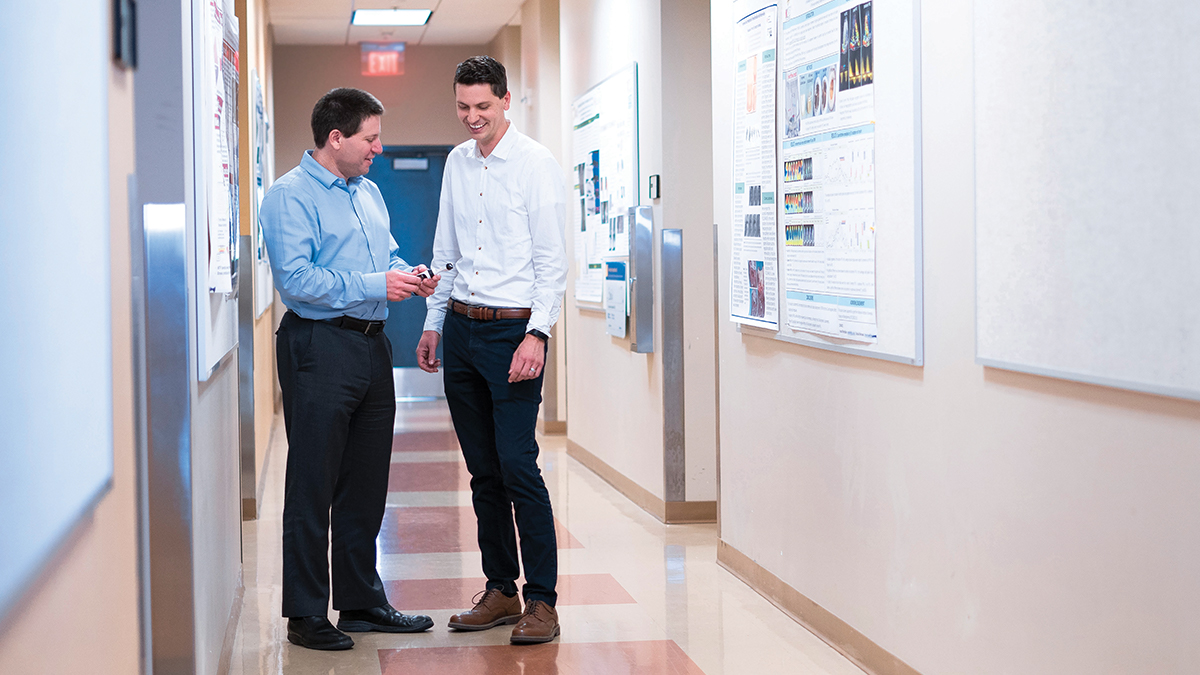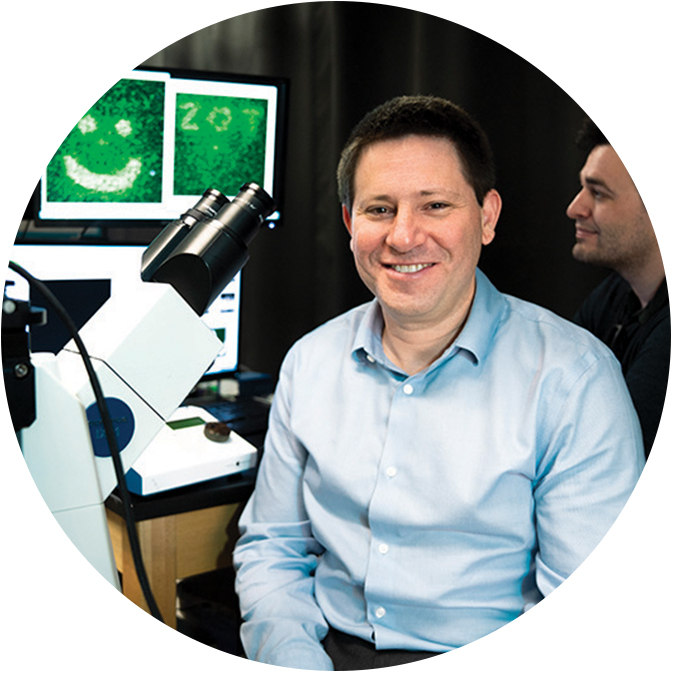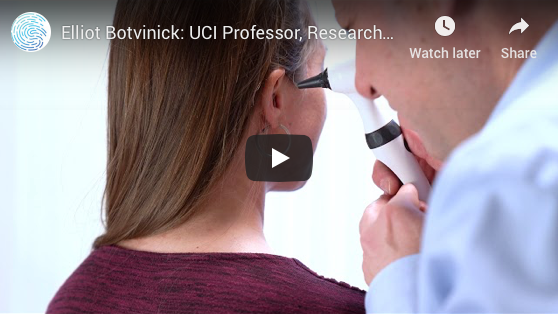Elliot Botvinick: UCI Professor, Researcher turned Entrepreneur Extraordinaire
He and his team of researchers plan to save lives one med tech startup at a time

May 21, 2019 - Within the glass walls of UCI’s massive Henry Samueli School of Engineering lies several labs fashioning innovative devices and concepts, many with commercial potential. While wandering through the second floor of labyrinth-like hallways, one might stumble upon the Edwards Lifesciences Center for Advanced Cardiovascular Technology and, behind secure access, Elliot Botvinick, Ph.D., and his team of researchers tinkering away with innovations that could one day save millions of lives.
Since 2001, Botvinick, a biomedical engineering professor, has accumulated more than 20 invention reports and four patents issued through UCI Applied Innovation. But there’s no rest for the weary as Botvinick continues to forge the path for his team – all who live and breathe innovation for the greater good.
The name of the game is “rapid detection” and Botvinick and his team apply it to ear infections in children, Type 1 diabetes and sepsis.

Cactus Medical
Botvinick has an exclusive option to license the technology for a rapid detection device for ear infections with Cactus Medical, a startup company that utilizes an all-optical noninvasive way of detecting fluid in the ear – otherwise known as middle ear effusion – in children, an often misdiagnosed condition leading to over-prescription of antibiotics.
“Elliot has a real knack for entrepreneurialism, so he’s been involved with a number of different companies,” said Sean White, entrepreneur and co-founder of Cactus Medical. “Elliot really plays to his strengths, which is taking all these intellectual assets that he has and then building companies in such a way that they leverage those assets in the best way possible.”
Along with Botvinick, CEO Samir Shreim and three others, White co-founded the company based on Botvinick laboratory’s rapid detection technology. What appears to be a standard otoscope, a medical device used to look into the ears, now has, as the team calls it, a “magic button” that, in addition to a visual assessment, provides the clinician with a metric that tells them if the child has middle ear effusion.
“The magic button is key,” said Samir Shreim. “We’ve spoken to physicians all over the country about their challenges in diagnosing ear infections in young kids. The key is that it has to be simple and easy to use. Our tech is sophisticated, but it’s reliable and easy for the user. That’s the hallmark of good engineering, it’s Elliot’s hallmark and the key to our success.”

Applied Innovation
Botvinick’s relationship with UCI Applied Innovation has been prolific. In 2016, he was one of the first UCI researchers to receive funding for his technology licensed to Cactus Medical through Applied Innovation’s Proof of Product Grant program(POP Grants), a program that accelerates the development of UCI’s commercially promising technology. Since 2016, the program has incorporated funds from Assembly Bill 2664 (see sidebar). The bill continues to fund technologies across campus that have commercial potential. Cactus Medical also recently secured a National Science Foundation phase 1 SBIR grant of $225,000 and the support of the Consortium for Technology in Innovation in Pediatrics, an FDA-sponsored pediatric device accelerator. Cactus is developing partnerships with clinical sites for data collection, as they hone their go-to-market strategy and further refine their technology.
In addition to Applied Innovation’s POP Grants program, Botvinick has also participated in the I-Corps program where he was an industrial mentor for researchers in the program. He also utilizes Applied Innovation’s licensing officers for patenting services.
“It’s a close relationship allowing us to use patent attorneys and just being involved every step of the way,” said Botvinick. “When I speak to my colleagues at other universities, they simply don’t have this experience. Richard [Sudek] has created something special and rare. In fact, what he built is one of the reasons I never left UCI.”
Fieldionics, Inc.
In conjunction with Cactus Medical, Botvinick has also decided to focus on rapid detection of Type 1 diabetes. It started in 2016, after a speaker at the Beckman Laser Institute talked about the need to save injured soldiers who pass away despite normal vital signs. The speaker opened Botvinick’s eyes to lactic acid as the gold standard for triage care, patient risk determination and treatment guidance.
“They think a lot of preventable deaths are because they couldn’t tell they were severely injured,” said Botvinick.
In addition to a plethora of his other inventions, Botvinick found this gap in medical care for soldiers relative to several other medical application, like sepsis. He made it his mission to help save lives starting with configuring the detection of lactic acid in relation to Type 1 diabetes and sepsis.
“With lactic acid, most people think about your sore muscles after you exercise … it’s something that’s generated when you exercise too hard because you don’t have the oxygen,” said Botvinick. “When these patients are bleeding internally, the same effect occurs – they become inadequately oxygenated and the body starts producing lactic acid.”
Botvinick’s former grad student, and now co-founder of Cactus Medial and Fieldionics, John Weidling, Ph.D., developed a version of the continuous sensor as his thesis and after nine months, the team had a continuous lactate monitor working in a rabbit model and conducted their first human study in 2016.

Multiple Applications
Following 2016’s intensive human study, the timeline began to blur for Botvinick once a large research foundation caught wind of the project and asked if the same technology could apply to measuring glucose.
Type 1 diabetes, also known as juvenile diabetes, is a chronic condition where the pancreas, a large gland located behind the stomach that secretes digestive enzymes, produces little or no insulin, a necessary hormone that regulates blood sugar levels. According to the Juvenile Diabetes Research Foundation, some 1.25 million Americans are living with Type 1 diabetes, which includes 200,000 who are less than 20 years old.
“Right now there are glucose sensors on the market and they’re fabulous,” said Botvinick. “If you’re going to take that data and tell a pump how much insulin to deliver, what do you do when it’s unknown? How you are going to trend – high or low – in the next three hours after exercise?”
People with Type 1 diabetes often closely monitor their diet and exercise routines to determine blood sugar levels, according to Botvinick. This summer, Botvinick will kick off a study at UCI that will determine if lactic acid is a reliable predictor of blood glucose trends following different types of exercise for people who have diabetes.
“The study has been approved, the devices have been vetted and we will be the first people in the world to answer whether or not knowing lactic acid can tell you what your sugar is going to be,” said Botvinick.
The Future is Bright
Botvinick’s lab group, Bio-Engineering of Advanced Mechanical Systems (BEAMS), has locations at the Beckman Laser Institute & Medical Clinic and the Edwards Lifesciences Center for Advanced Cardiovascular Technology, where he and his team construct tiny, and not-so-tiny, devices that can make big differences in patient’s lives.
Although Botvinick’s innovations continue to progress within the walls of his labs, his primary focus remains on Cactus Medical, which is already taking foot down a path toward commercialization. Following not too far behind, he plans to take Fieldionics, Inc., to market by working with medical device companies, such as Dexcom, known best for their glucose monitoring systems. Further, Professor Ali Mohraz, Department of Chemical and Biomolecular Engineering, and Botvinick recently received a large grant to develop a new insulin infusion set for extended lifetime and faster delivery.
“If the infusion set works, we have every intention of disrupting the infusion set market, it’s a multibillion-dollar market,” said Botvinick.
If Fieldionics, Cactus Medical and the infusion set materializes into commercial successes, then Botvinick imagines working toward erecting a biomedical engineering building at UCI.
“My main focus would be to keep the snowball going – donating money toward a BME building, and ultimately having people who are smarter than me invent better things, get them commercialized and save people’s lives,” said Botvinick.
- Jackie Connor / UCI

